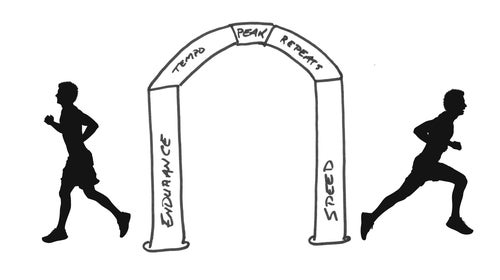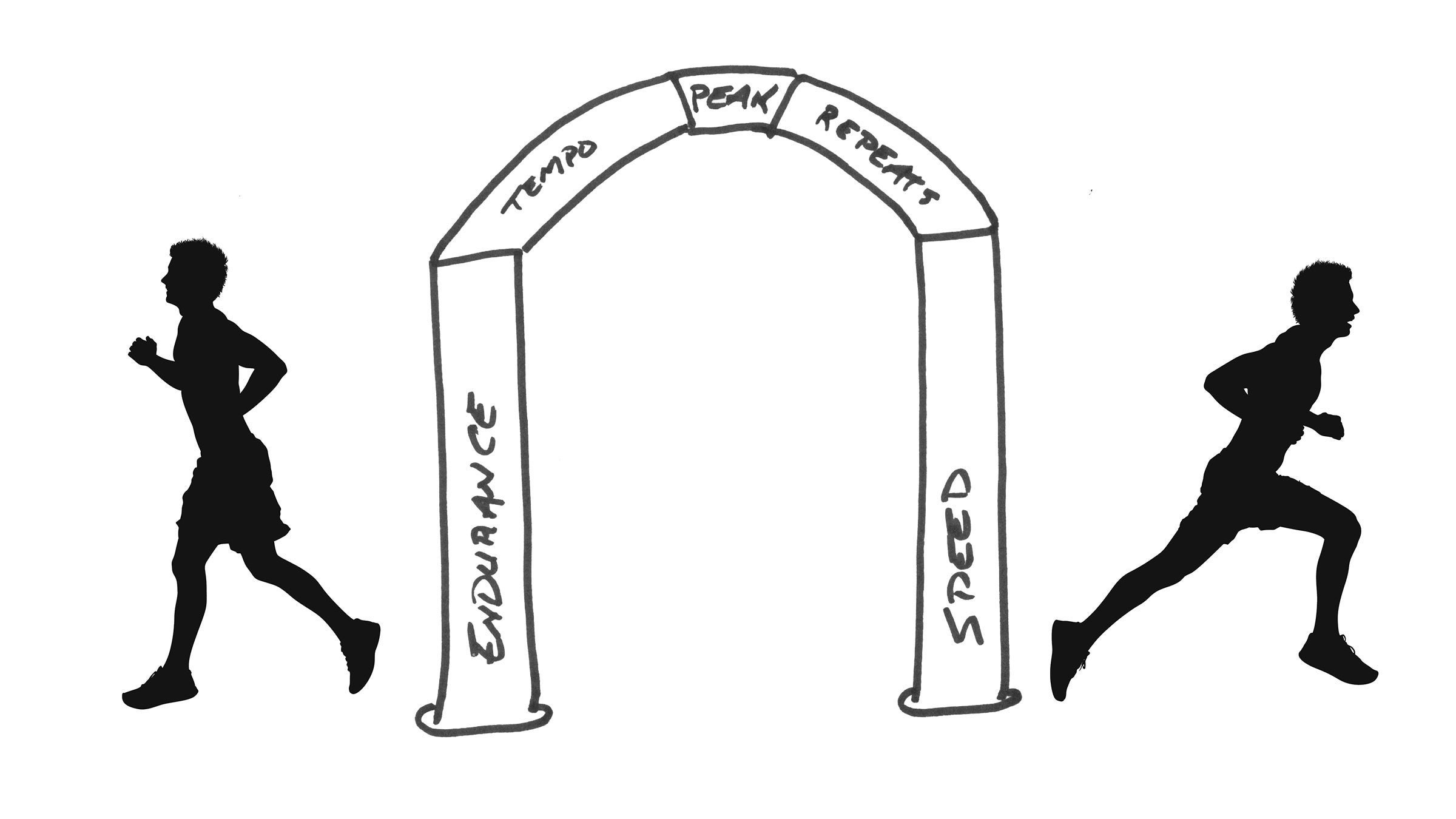Many runners think of training as practice, spending a lot of their time at or close to their goal race pace. They’re continually testing their fitness or simply fall into running as fast as they comfortably can on any given day. Training this way, however, simply refines the abilities you have now. You can make incremental improvements with race-pace training, but you can’t create big transformations in your running ability.
Top runners, in contrast, view most of their training as conditioning — raising their bodies’ capacity for endurance and speed before they sharpen for a race. To do that, these athletes first work the extremes, spending time at both ends of the speed spectrum to build the foundation that will lift them to a new level and allow them to handle the more specific training.
You might picture this like building an arch over two pillars. Once you start bridging between the two sides, you have a limited height before you reach the peak in the center. Each pillar, however, can be built to any height and stand strong before you start the final push to the central peak. Those pillars are endurance and neuromuscular speed, and are built by running both comfortably slow and intensely fast.
Why Some of Your Training is Too Fast
The fundamental task for every distance runner is to first build their aerobic endurance. Even a sedentary person can run after a bus, but to keep the pace up you need to transform your cardiorespiratory system. “You need to build an aerobic base,” says Brad Hudson, elite coach and author of Run Faster. To do that, he says, requires, “Just running and running more.”
You can’t run more if you’re going too fast, however, or you’ll get hurt. Slowing down your pace is necessary to go longer. To build your aerobic system, increase volume instead of speed. You want to increase the length and frequency of your daily runs and put in weekly long runs of at least 90 minutes. Hudson’s elite athletes will do several slow runs a week in their fundamental training periods, and, he says, “The less experienced the athlete, the more they need to be running at 70–80 percent of their race pace.”
Besides the risk of injury, training too fast can sabotage your aerobic gains. When you push past your aerobic thresholds, the anaerobic energy production produces acidic waste — which can damage your mitochondria and the enzymes that help release energy from fuel. Building these power-cell mitochondria and their enzymes is one of the purposes of aerobic training, so training too fast can directly derail your progress as well as speed your path to burn-out.
Why Some of Your Training Is Too Slow
At the same time, however, Hudson says you need to be doing high-intensity neuromuscular work. “The big difference between fast and slow people is that fast people are fast,” Hudson says. “Their ground contact time is faster, they generate more power, they move better. You can have a great aerobic base, and if you can’t move you’re not going to run fast.”
You don’t learn to move better by going long, or even by doing 5K-paced speed work. Neuromuscular training involves brief, all-out efforts that recruit all your muscles and neural pathways, plus require your full range of motion.
Hudson uses 10-second repeats up short, steep hills or more traditional “strides” — 60 to 100 meter accelerations to your top speed. Start with a couple if you’ve never done them before, and work up to 8 to 10. These bursts are short enough to avoid aerobic energy production and its negative side-effects, and intense enough to require your brain to pay attention and create more efficient movement patterns.
Why The Ends Are Important
Eventually you need to work toward the middle, putting in specific training closer to your race pace. But working the ends lets you fully benefit fully from that training. “The intensity stuff, the specific stuff: that’s the goal,” Hudson says. “But to get there and make that digestible and absorbable, they need to have a huge aerobic base. The fundamental period is when you want to build your engine, build endurance.”
“Do the training so you can do the training so you can finally do the training to achieve your race goal,” says coach and author Greg McMillan. “The idea being that in order to have your best race-specific training, you need to make sure you have the ‘fundamentals’ of running taken care of.” By building this base, your specific race training will be faster, more effective, and take less time, reducing your injury risk.
Both Hudson and McMillan recommend a four- to eight-week fundamental period where you do mostly easy volume with short, fast speed a couple of times per week. Then you spend another four to eight weeks starting to work toward the middle: add marathon-pace runs and tempo runs on one end, and slightly longer speed workouts like 200-meter repeats on the other. In the final period, you incorporate race-specific workouts like long intervals. Even in this final period, however, top athletes maintain easy long runs and short, intense neuromuscular work, using a wide diversity of paces as they train every system while staying healthy.
Don’t fall into the trap of trying to inch the roof peak slightly higher every day. Try slowing down on most days and pushing the pedal to the metal for a few seconds on a few — building each supporting pillar higher and higher. Give this time to work before you aim your training toward a race. When you get ready to sharpen and run your fastest at a pace in the middle, you’ll find you have the lungs to go far and the legs to fly.


